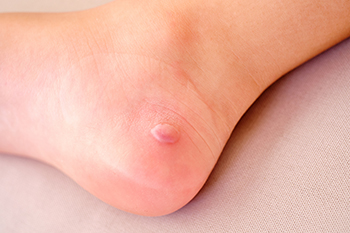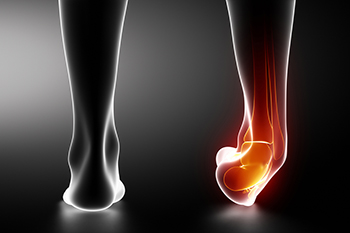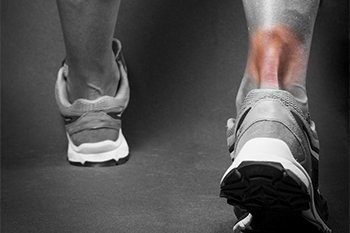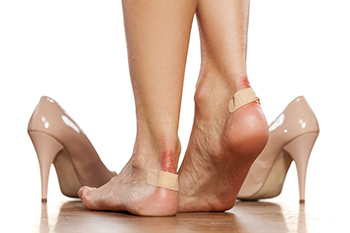Items filtered by date: November 2024
Facts About Foot Blisters

Foot blisters are small, fluid-filled sacs on the skin, that typically form due to friction, heat, or moisture. They most commonly develop on the feet while running, hiking, or walking long distances. The repeated rubbing of shoes against the skin causes the outer layer of the skin to separate, leading to a buildup of fluid underneath. Blisters can also form if the feet become excessively sweaty or if wearing ill-fitting shoes causes pressure on certain areas of the foot. Although generally not serious, foot blisters can be painful and make walking or running uncomfortable. To prevent blisters, it is important to wear properly fitted shoes, keep the feet dry, and use blister prevention products such as socks designed for moisture wicking or blister pads. Foot blisters can easily become infected, causing pain and discomfort. If this has happened to you, it is suggested that you consult a podiatrist who can offer you relief and prevention methods.
Blisters are prone to making everyday activities extremely uncomfortable. If your feet are hurting, contact Shalonda Davidson, DPM of Instride Carolina Foot Care. Our doctor can provide the care you need to keep you pain-free and on your feet.
Foot Blisters
Foot blisters develop as a result of constantly wearing tight or ill-fitting footwear. This happens due to the constant rubbing from the shoe, which can often lead to pain.
What Are Foot Blisters?
A foot blister is a small fluid-filled pocket that forms on the upper-most layer of the skin. Blisters are filled with clear fluid and can lead to blood drainage or pus if the area becomes infected.
How Do Blisters Form?
Blisters on the feet are often the result of constant friction of skin and material, usually by shoe rubbing. Walking in sandals, boots, or shoes that don’t fit properly for long periods of time can result in a blister. Having consistent foot moisture and humidity can easily lead to blister formation.
Prevention & Treatment
It is important to properly care for the affected area in order to prevent infection and ease the pain. Do not lance the blister and use a Band-Aid to provide pain relief. Also, be sure to keep your feet dry and wear proper fitting shoes. If you see blood or pus in a blister, seek assistance from a podiatrist.
If you have any questions, please feel free to contact our office located in Statesville, NC . We offer the newest diagnostic and treatment technologies for all your foot care needs.
Managing Ankle Sprains

A sprained ankle usually happens when the ankle rolls inward, leading to stretching or tearing of the ligaments on the outside of the foot. This injury can cause pain, swelling, and difficulty bearing weight, although some people may still manage limited movement. Ankle sprains vary in severity, with mild cases involving minor ligament stretching, and severe cases leading to extensive tears, or ruptures, in the ankle's supporting ligaments. The risk of ankle sprains is higher in those individuals with previous sprains, high arches, or who participate in high-impact sports. Once the initial swelling subsides, certain exercises may be recommended to restore strength, balance, and range of motion, in an effort to prevent future injuries. A podiatrist can assess the severity of the injury, provide guidance on treatment options, and discuss options like bracing in severe cases. If you have sprained an ankle, it is suggested that you schedule an appointment with a podiatrist for a full exam, diagnosis, and treatment.
Although ankle sprains are common, they aren’t always minor injuries. If you need your ankle injury looked at, contact Shalonda Davidson, DPM from Instride Carolina Foot Care. Our doctor can provide the care you need to keep you pain-free and on your feet.
How Does an Ankle Sprain Occur?
Ankle sprains are the result of a tear in the ligaments within the ankle. These injuries may happen when you make a rapid shifting movement while your foot is planted. A less common way to sprain your ankle is when your ankle rolls inward while your foot turns outward.
What Are the Symptoms?
- Pain at the sight of the tear
- Bruising/Swelling
- Ankle area is tender to touch
- In severe cases, may hear/feel something tear
- Skin discoloration
Preventing a Sprain
- Wearing appropriate shoes for the occasion
- Stretching before exercises and sports
- Knowing your limits
Treatment of a Sprain
In many cases, the RICE method (Rest, Ice, Compression, and Elevate) is used to treat ankle sprains. However, you should see a podiatrist to see which treatment option would work best with your injury. In severe cases, surgery may be required.
It is important to ask your doctor about rehab options after you receive treatment for your injury. Stretching, strength training, and balance exercises may help the ankle heal while also preventing further injury.
If you have any questions, please feel free to contact our office located in Statesville, NC . We offer the newest diagnostic and treatment technologies for all your foot care needs.
Repairing an Achilles Tendon Injury

The Achilles tendon connects the calf muscles to the heel bone. It enables essential foot movements like pointing the toes and pushing off when walking or running. Achilles tendon injuries often result from intense physical activities, such as sudden acceleration, landing hard on the heel, or stepping onto an uneven surface. If the tendon ruptures, surgery may be necessary to restore functionality. During the procedure, a podiatrist carefully brings the tendon ends together and sutures them to promote proper healing. However, non-surgical treatments are sometimes effective, particularly for partial tears, and involve structured rehabilitation methods to encourage recovery. Potential risks from surgical repairs include infection, nerve damage, scarring, or even re-injury, underscoring the importance of having a podiatrist assess the condition and provide guidance on the best approach. With proper care, most people regain significant mobility and strength in the affected foot. If you have injured your Achilles tendon, it is suggested that you schedule an appointment with a podiatrist for treatment.
Achilles tendon injuries need immediate attention to avoid future complications. If you have any concerns, contact Shalonda Davidson, DPM of Instride Carolina Foot Care. Our doctor can provide the care you need to keep you pain-free and on your feet.
What Is the Achilles Tendon?
The Achilles tendon is a tendon that connects the lower leg muscles and calf to the heel of the foot. It is the strongest tendon in the human body and is essential for making movement possible. Because this tendon is such an integral part of the body, any injuries to it can create immense difficulties and should immediately be presented to a doctor.
What Are the Symptoms of an Achilles Tendon Injury?
There are various types of injuries that can affect the Achilles tendon. The two most common injuries are Achilles tendinitis and ruptures of the tendon.
Achilles Tendinitis Symptoms
- Inflammation
- Dull to severe pain
- Increased blood flow to the tendon
- Thickening of the tendon
Rupture Symptoms
- Extreme pain and swelling in the foot
- Total immobility
Treatment and Prevention
Achilles tendon injuries are diagnosed by a thorough physical evaluation, which can include an MRI. Treatment involves rest, physical therapy, and in some cases, surgery. However, various preventative measures can be taken to avoid these injuries, such as:
- Thorough stretching of the tendon before and after exercise
- Strengthening exercises like calf raises, squats, leg curls, leg extensions, leg raises, lunges, and leg presses
If you have any questions please feel free to contact our office located in Statesville, NC . We offer the newest diagnostic tools and technology to treat your foot and ankle needs.
High Heels and Blisters

High heels are a popular shoe choice for many, but they can often lead to painful foot blisters. The structure of high heels places excessive pressure on specific areas of the feet, particularly the toes and the heel, which can cause friction against the shoe material. This friction, combined with sweat and prolonged wear, creates an ideal environment for blisters to form. To avoid this discomfort, selecting well-fitted shoes with adequate padding and support is essential. Wearing thick socks or protective blister pads can help reduce friction. It is also beneficial to gradually break in new heels by wearing them for short periods. Additionally, maintaining foot hygiene and keeping feet dry can minimize the risk of blisters. If you have problematic blisters from wearing high heels, it is suggested that you consult a podiatrist who can offer you relief and additional prevention tips.
High heels have a history of causing foot and ankle problems. If you have any concerns about your feet or ankles, contact Shalonda Davidson, DPM from Instride Carolina Foot Care. Our doctor can provide the care you need to keep you pain-free and on your feet.
Effects of High Heels on the Feet
High heels are popular shoes among women because of their many styles and societal appeal. Despite this, high heels can still cause many health problems if worn too frequently.
Which Parts of My Body Will Be Affected by High Heels?
- Ankle Joints
- Achilles Tendon – May shorten and stiffen with prolonged wear
- Balls of the Feet
- Knees – Heels cause the knees to bend constantly, creating stress on them
- Back – They decrease the spine’s ability to absorb shock, which may lead to back pain. The vertebrae of the lower back may compress.
What Kinds of Foot Problems Can Develop from Wearing High Heels?
- Corns
- Calluses
- Hammertoe
- Bunions
- Morton’s Neuroma
- Plantar Fasciitis
How Can I Still Wear High Heels and Maintain Foot Health?
If you want to wear high heeled shoes, make sure that you are not wearing them every day, as this will help prevent long term physical problems. Try wearing thicker heels as opposed to stilettos to distribute weight more evenly across the feet. Always make sure you are wearing the proper shoes for the right occasion, such as sneakers for exercising. If you walk to work, try carrying your heels with you and changing into them once you arrive at work. Adding inserts to your heels can help cushion your feet and absorb shock. Full foot inserts or metatarsal pads are available.
If you have any questions please feel free to contact our office located in Statesville, NC . We offer the newest diagnostic and treatment technologies for all your foot and ankle needs.
